Hello, fellow bird enthusiasts! 🐦 It’s your avian aficionado, Happy Birding, here to brighten your day with a splash of sunshine and a dash of midnight. Today, we’re embarking on a global trek to celebrate some feathery marvels. Our stars? The captivating black and yellow birds that grace our skies, forests, and imaginations. From the Americas to the cozy corners of Europe and vast landscapes of Asia, we’re in for a colorful journey. So, grab your binoculars, and let’s flutter into the world of these winged beauties!
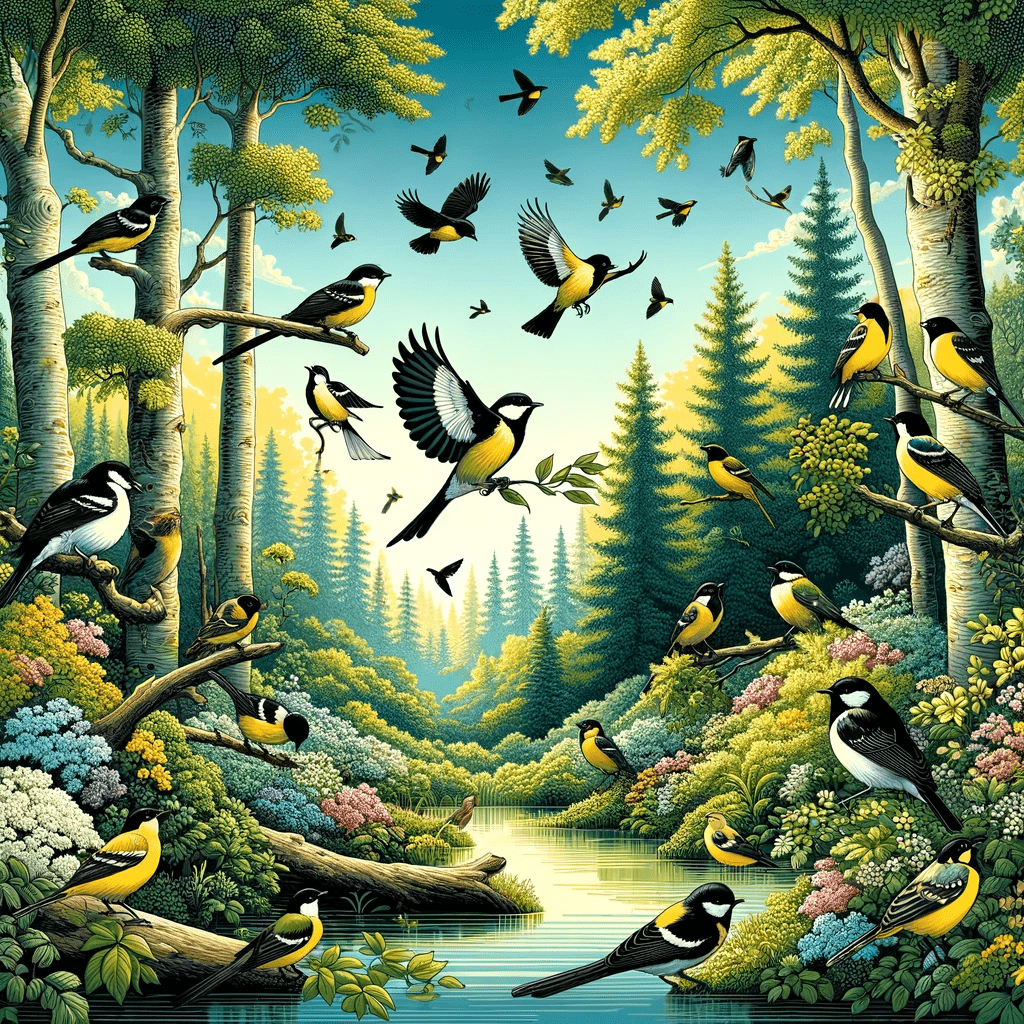
Imagine a flutter of black and yellow amidst the green canopy—a living spark of contrast and vibrancy. This is the allure that draws us to the colorful world of birds. Among them, black and yellow avians offer some of nature’s most stunning visual symphonies. Whether it’s the golden melodies of finches or the striking black of orioles, these birds don’t just inhabit regions; they adorn them.
In this blog, we’ll globe-trot across continents, visiting diverse habitats because, believe it or not, these colors are not just for show. They’re part of a complex ecological tapestry. From the rainforests of South America to the temperate regions of North America and the varied terrains of Europe and Asia, each bird plays a vital part in its environment. Ready to meet them? Feathered binoculars at the ready, and away we go!
North American Black and Yellow Birds
Ah, North America, a land diverse in its avian inhabitants. Here, amidst the amber waves of grain and purple mountain majesties, black and yellow birds add a splash of living color.
1. American Goldfinch
The American Goldfinch, also known as the “wild canary,” is a spectacle of brilliance, with its vibrant yellow plumage standing out against a backdrop of green foliage or the clear blue sky. Males are particularly striking with their vivid yellow bodies, black wings, and a black forehead cap that looks like it’s been painted on. Females, while more subdued, sport an olive-yellow hue that provides perfect camouflage while nesting.
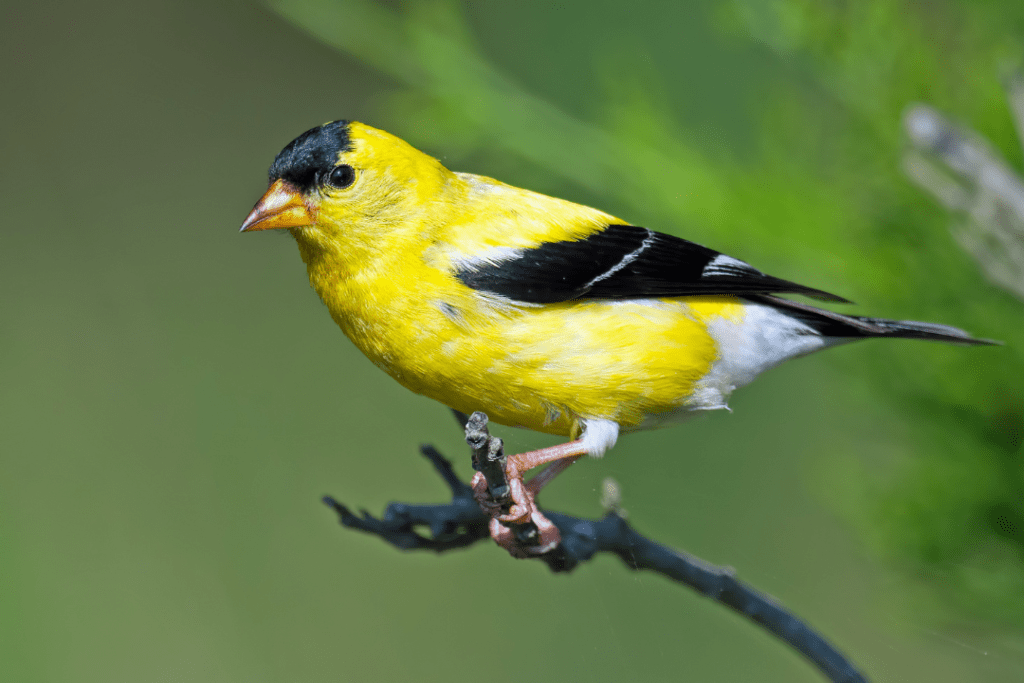
These finches have a delightful diet preference: they adore seeds! Sunflower fields and thistle plants are their dining rooms. They’re meticulous eaters, often acrobatically hanging upside down from stems to access their meals. Their eating habits are so seed-centric that they even feed their young an exclusively seed-based “milk,” unique among the avian world.
Habitat and geographic range: These beauties love the suburbs as much as open country, weaving through meadows and gardens across Canada, and the United States. They’re particularly fond of sunflower-laden fields.
Habitat and geographic range
These beauties love the suburbs as much as open country, weaving through meadows and gardens across Canada, and the United States. They're particularly fond of sunflower-laden fields.
Size
Petite and sweet, they range from 11 to 14 cm in length.
Life expectancy
On average, these golden guys enjoy a life of about 3 to 6 years, though some have been known to hit the ripe age of 11.
Spotting tips
Listen for their sweet, long, and varied song, and keep an eye out in overgrown fields. Better yet, lure them with bird feeders filled with thistle or Nyjer seeds. They simply can't resist.
2. Yellow Warbler
The Yellow Warbler is a bright splash of sunshine, aptly named for its lemon-yellow plumage. These small, sprightly birds have an undeniably cheerful appearance, with males showcasing rusty, striped patches down their breast—nature’s version of an exquisite suit. The females are slightly paler, with more subtle striping, beautifully camouflaged among the leaves.
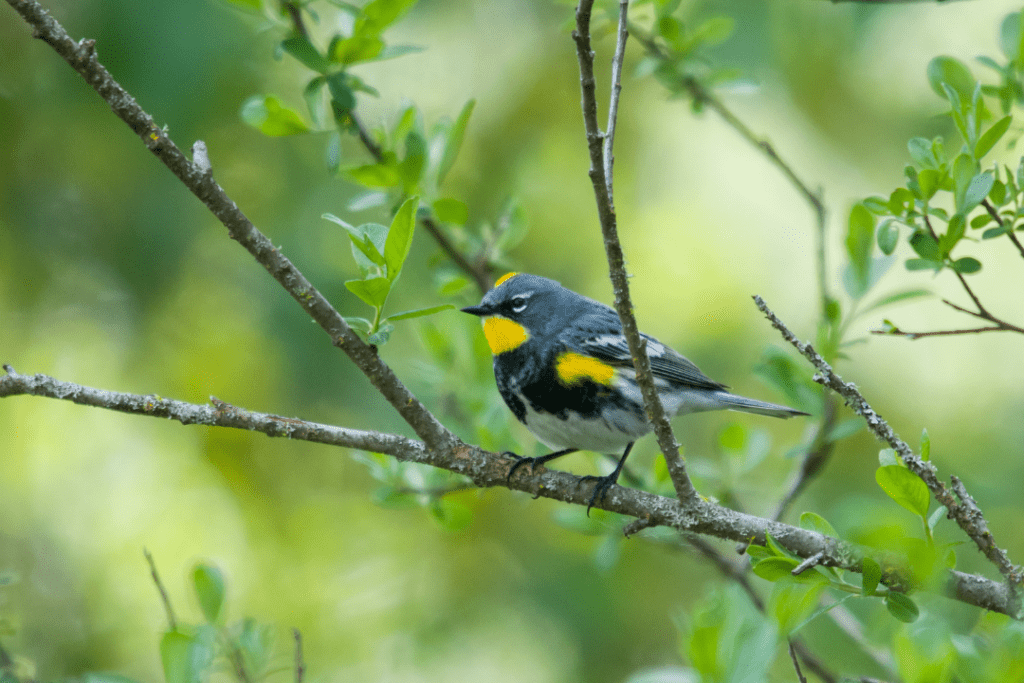
They are insect aficionados, actively hunting for caterpillars, beetles, and midges among foliage, showcasing acrobatic feats. You’ll often spot them in shrubs and trees near water bodies, flitting about with purposeful energy. Their sweet, melodious song sounds like they’re joyously proclaiming, “Sweet, sweet, I’m so sweet,” making them a delightful listening companion on a warm, sunny day.
The female is a master architect, constructing the nest from delicate materials like moss, lichen, and spider silk, forming a compact, watertight cup. The craftsmanship is so exquisite that the nest stretches to accommodate growing nestlings. This period is one of the few times goldfinches become territorial, with the male diligently guarding his family and fending off intruders.
Habitat and geographic range: Inhabitants of thickets alongside streams and ponds, they breed throughout the U.S., Canada, and even up to Alaska.
Habitat and geographic range
Inhabitants of thickets alongside streams and ponds, they breed throughout the U.S., Canada, and even up to Alaska.
Size
Small but mighty, they stand tall at 12 to 19 cm.
Life expectancy
These warblers live approximately 7 to 8 years, filling the air with song each spring.
Spotting tips
Follow their song—a sweet series of whistles—to catch them flitting about in low branches. But be respectful; these little ones are wary of human disturbances.
3. Hooded Oriole
The Hooded Oriole claims attention with its sharp black and yellow coloration. Males boast a vibrant orange-yellow body contrasted dramatically with a jet-black face, throat, and back—a remarkable combination that makes them easy to spot against the green foliage. Females wear a more understated outfit, decked in pale yellow and gray tones, perfect for blending discreetly into their surroundings.
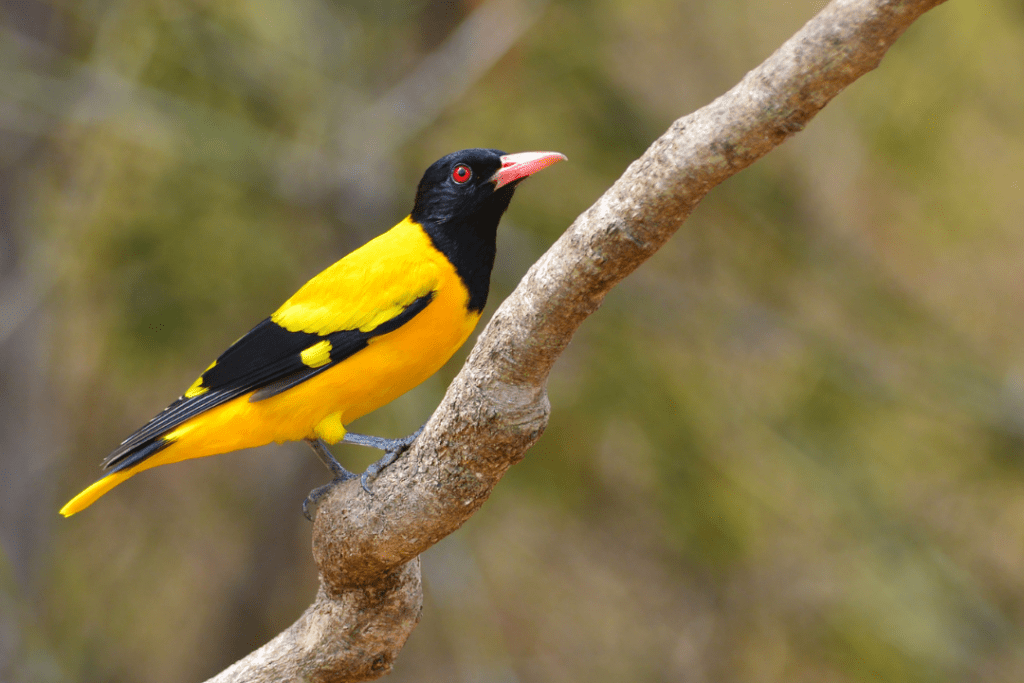
These birds have a penchant for nectar, often seen sipping from flowers with their slender, curved beaks, deftly avoiding the hustle of bees. They also have a fondness for fruit and the occasional insect. Intriguingly, they often use their slender beaks to skillfully weave hanging nests from palm fronds or leafy plants, creating a safe haven for their offspring.
Habitat and geographic range: They love the warmth, found in the southwestern U.S. and Mexico. They’re all about sylvan territories or palm tree resorts.
Habitat and geographic range
They love the warmth, found in the southwestern U.S. and Mexico. They're all about sylvan territories or palm tree resorts.
Size
A medium-sized songbird, they measure around 17 to 23 cm.
Life expectancy
These orioles typically live for about 11 years, sometimes longer in a safe, nourishing environment.
Spotting tips
Look up in palm trees and listen for their whistling and chattering. Want to invite them over? Set up a feeder with jelly, fruit, or nectar.
4. Yellow-headed Blackbird
The Yellow-headed Blackbird is a striking creature with its bold color pattern. The males are particularly ostentatious with their vivid yellow heads and chests, sharply contrasted with black bodies and white wing patches. Females are more subdued with brownish bodies and duller yellow markings, a muted elegance that serves them well in their marshy homes.
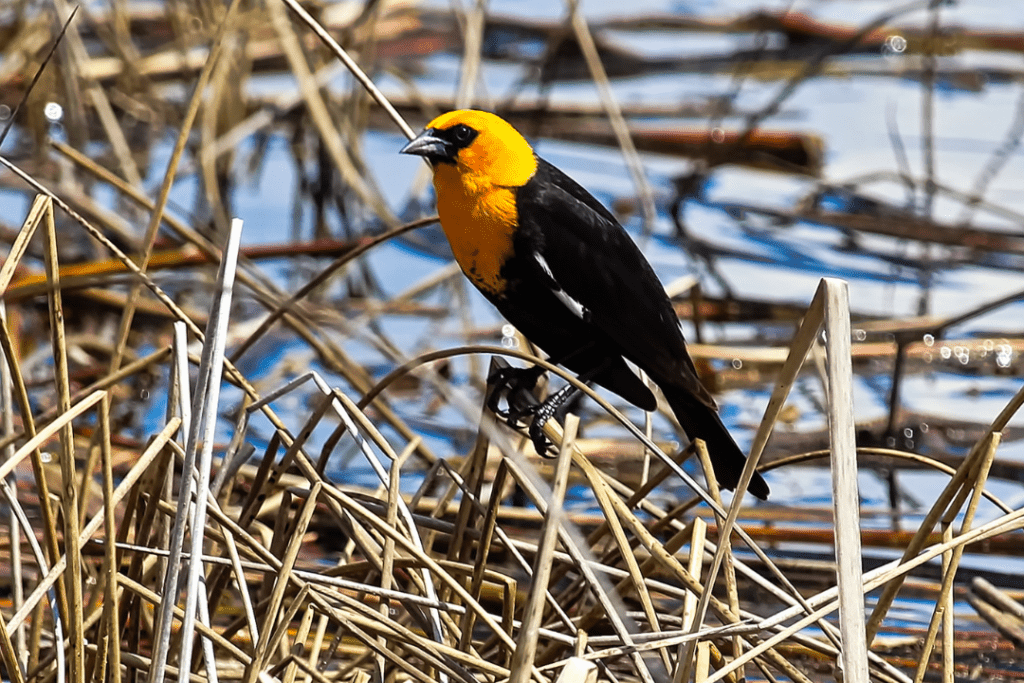
Their diet primarily consists of seeds and insects, foraged from their marshy surroundings or nearby agricultural fields. They’re social creatures, often found in large, noisy colonies. Their song, if it can be called that, is a cacophony of harsh, raspy notes, more startling than musical but part of their undeniable charm.
Habitat and geographic range: Marshes and prairies are their playgrounds, mainly in the western and Midwestern U.S.
Habitat and geographic range
Marshes and prairies are their playgrounds, mainly in the western and Midwestern U.S.
Size
These are large blackbirds, about 20 to 24 cm in length.
Life expectancy
They typically enjoy life for around 2 to 4 years.
Spotting tips
Scan the cattails and listen for their harsh calls. They're social birds and often found amidst flocks, putting on quite the show.
5. Lesser Goldfinch
The Lesser Goldfinch presents a dazzling display of yellow and black, with males featuring a bright yellow underbody contrasted against a black (or sometimes greenish) upper body and cap. Females are more muted, with olive-gray tones gracing their upper parts and a lighter yellow below.
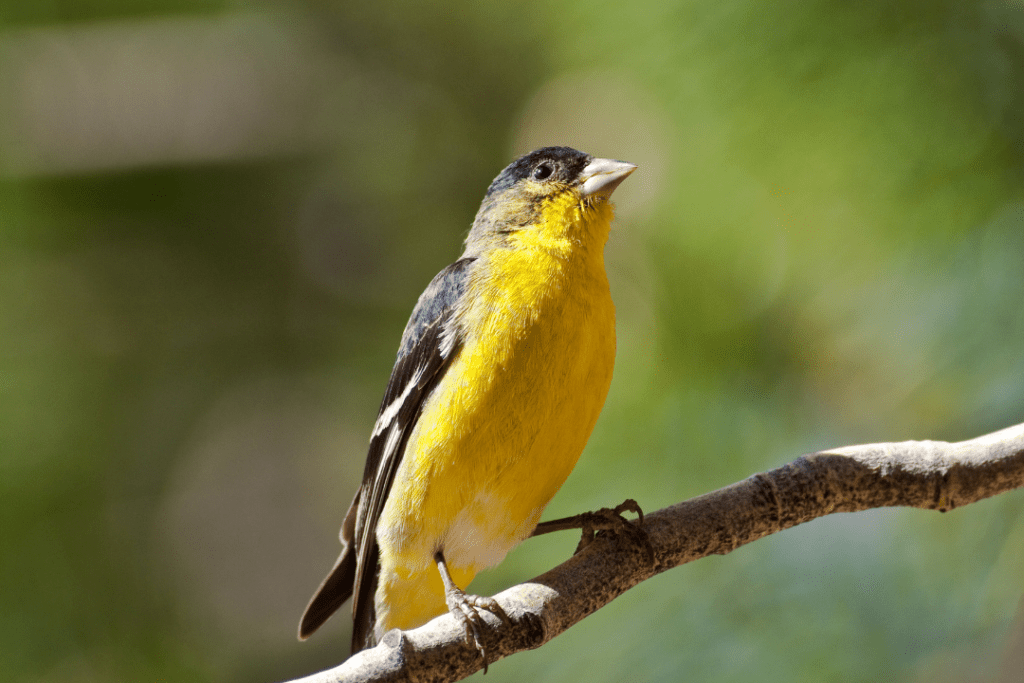
They are enthusiastic seed eaters, dining primarily on the seeds of flowers, trees, and weeds. They’re particularly fond of sunflower seeds and can often be seen clinging to plants, deftly extracting seeds with their conical beaks. These little finches have a pleasant, twittering song, adding a melodious backdrop to any garden they inhabit.
Habitat and geographic range: They prefer semi-open areas, ranging from the southwestern U.S. to South America. They adore your sunflower seeds, by the way.
Habitat and geographic range
They prefer semi-open areas, ranging from the southwestern U.S. to South America. They adore your sunflower seeds, by the way.
Size
These tiny charmers are usually 9 to 12 cm long.
Life expectancy
Their lifespan extends up to 5 years or more in favorable conditions.
Spotting tips
These finches are backyard favorites. A bird feeder with Nyjer or sunflower seeds is your ticket to a meet-and-greet session.
6. Tricolored Blackbird
The Tricolored Blackbird, a relative of the more common Red-winged Blackbird, is a sight to behold. Males are predominantly black with a distinctive red shoulder patch bordered with a thin line of white, while females are primarily brown, with streaks of black and white throughout.
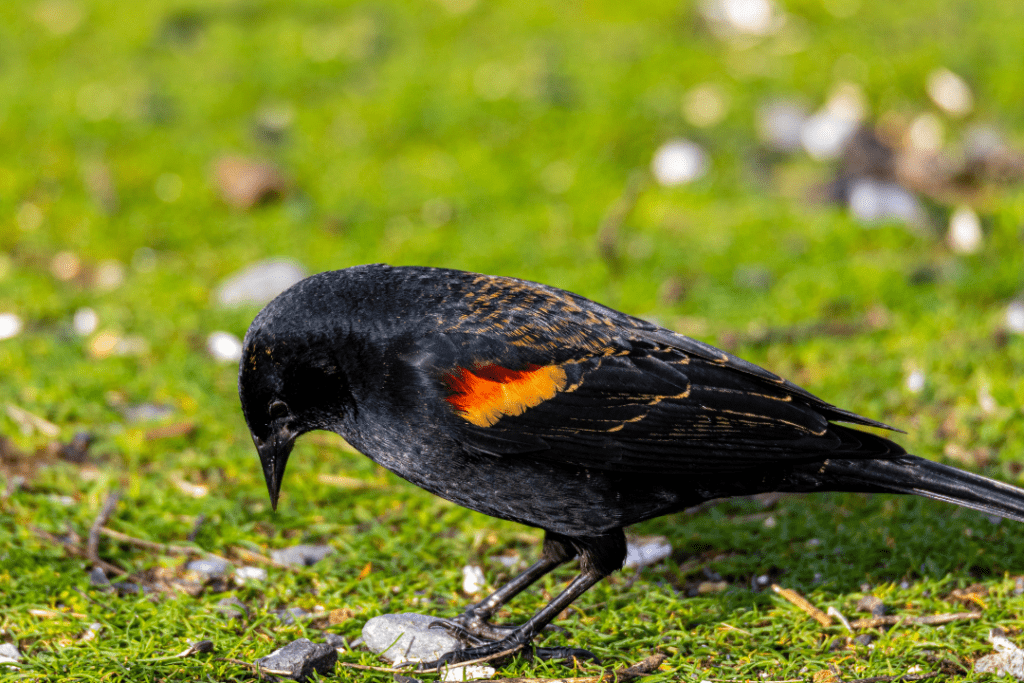
They feed on a mix of insects and seeds, often seen foraging on the ground with quick, deliberate pecks. They’re known for their massive colonial nesting sites, chosen for safety in numbers. Unfortunately, this social nesting habit puts them at risk, as damage to a single nesting site can impact thousands of these birds at once.
Habitat and geographic range: Almost endemic to California, these birds fancy marshes, grasslands, and coastal areas.
Habitat and geographic range
Almost endemic to California, these birds fancy marshes, grasslands, and coastal areas.
Size
Similar to their relative, the Red-winged Blackbird, they're about 20 to 23 cm.
Life expectancy
Life is relatively short but sweet, spanning around 2 to 4 years.
Spotting tips
Watch for the males' distinctive red patch and listen for their more guttural calls. Spotting one is a badge of honor for birdwatchers!
7. Black-throated Green Warbler
This delightful little bird is a study in contrast, with its black throat standing out against the bright yellow face. The rest of its body is a mix of olive and gray, with standout black streaking along its sides. Females are similarly patterned but slightly duller, allowing them to blend in more easily while tending to their nests.

Insects are their cuisine of choice, and they’re adept at catching them mid-air or foraging among foliage. They have a sweet, buzzy song, often repeated tirelessly throughout the day, making them a prominent voice in many North American forests.
Habitat and geographic range
These warblers breed in the northeastern U.S. and Canada's coniferous forests, wintering in Central America.
Size
A small sprite of a bird, it's around 12 to 15 cm.
Life expectancy
These warblers can live up to 8 years, blessing the forests with beauty and song.
Spotting tips
Their buzzy song "zoo-zee, zoo-zoo-zee" is a giveaway. Look for them in the mid-levels of eastern pine forests, particularly during migration.
8. Scott's Oriole
The male Scott’s Oriole is a vibrant yellow and black, drawing eyes wherever he flies. With a black hood extending through its chest and back contrasting against a bright yellow belly, it’s a sight of pure joy. The female opts for a more subtle look, with grayish-yellow tones that provide excellent camouflage.
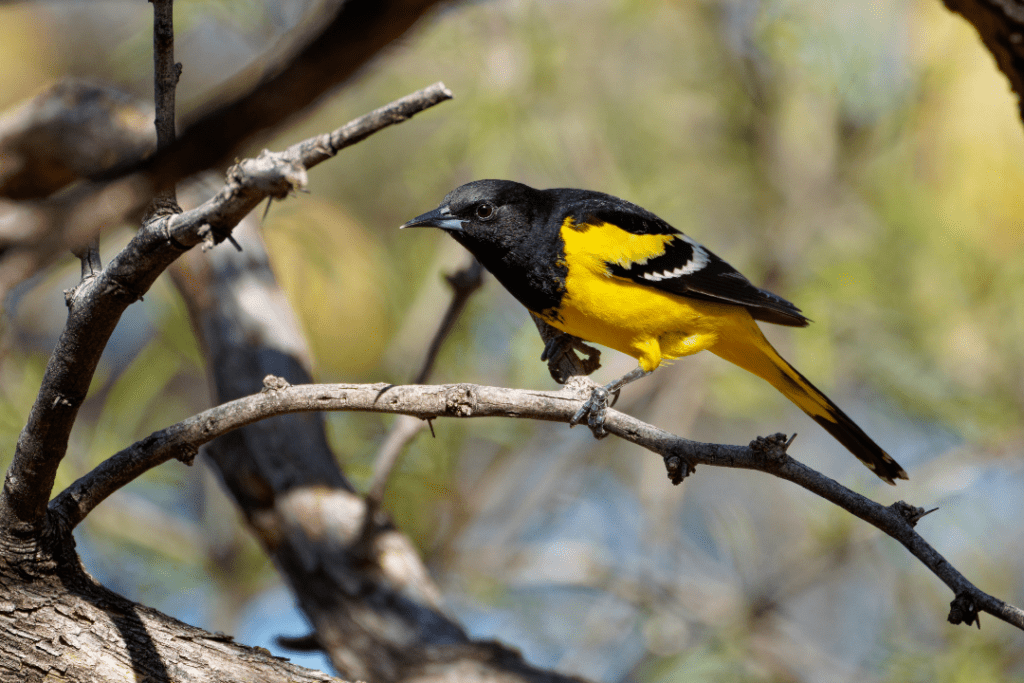
These birds are omnivores, with a diet consisting of insects, fruit, and nectar. They’re known for their beautiful, whistled songs, adding a melodious soundtrack to desert mornings. They’re also adept nest builders, creating hanging woven nests, often in palm trees or yucca plants.
Habitat and geographic range
Native to the southwestern U.S. and northern Mexico, they prefer open areas with yuccas and agaves.
Size
They stand out at 20 to 23 cm, a medium-sized flash of color.
Life expectancy
They live around 7 to 8 years, often hidden away in their desert havens.
Spotting tips
Their sweet, whistled song will draw your ear. Look for them in Joshua trees or sipping from hummingbird feeders. A real desert delight!
Central and South American Black and Yellow Birds
We’re heading south now, where the tropics teem with a kaleidoscope of feathers. Here, color isn’t just beauty; it’s a language all its own.
9. Yellow-rumped Cacique
The Yellow-rumped Cacique is a study in contrast and elegance. This bird features a primarily black body, but as its name suggests, it sports a bright yellow rump, a splash of sunshine that makes it stand out in its native habitat. They have striking blue eyes, adding to their exotic appeal.
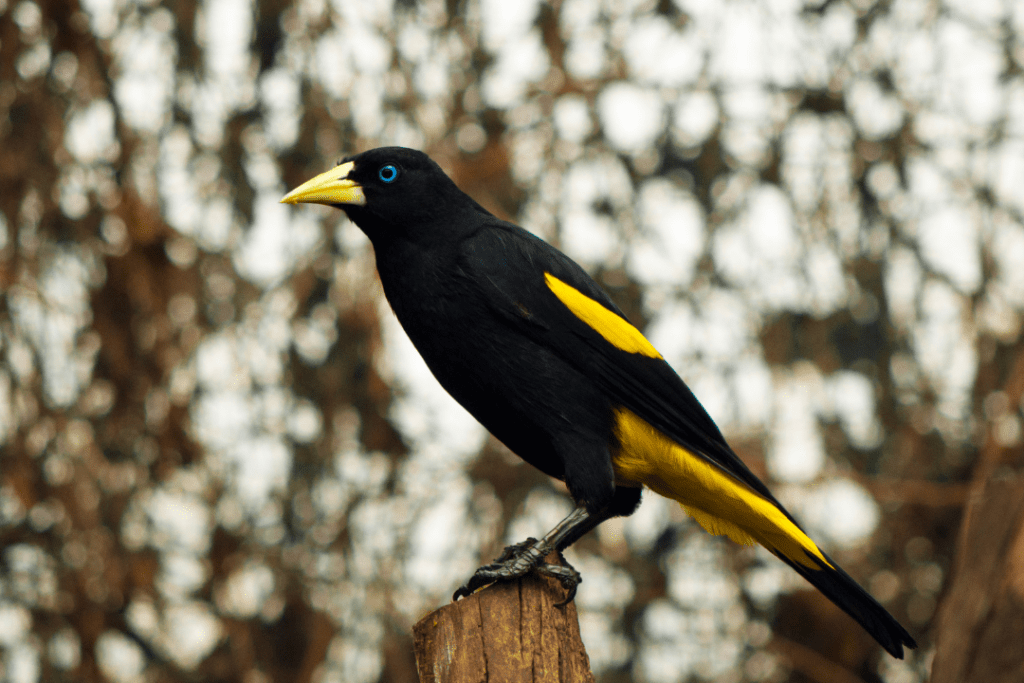
These birds feed mainly on insects and fruit. They have a fascinating social structure, living in colonies where several females mate with a single dominant male. Their nests, often built in hanging clusters like chandeliers, are a sight to behold, showcasing the intricacies of avian architecture.
Habitat and geographic range
They're tropical folks, found from Panama down through South America's northern regions. They love forest edges and clearings.
Size
A larger bird, they're about 28 cm long.
Life expectancy
These birds live around 15 to 20 years, often ruling over colonies with complex social structures.
Spotting tips
Look for their large colonies, often in open areas. Their nests hang like woven purses from trees—a sure sign you've found them!
10. Venezuelan Troupial
The national bird of Venezuela, the Venezuelan Troupial, is a vibrant orange, black, and white. The contrast is not just stunning but also unique among the New World orioles. Its body is primarily orange, with a black head, wings, and tail, and white patches on the wings and tail making it a visual delight.

These birds are known for their beautiful, varied songs and are also accomplished mimics. They’re quite territorial, often taking over other birds’ nests rather than building their own. Their diet is varied, including insects, fruit, and even smaller birds.
Habitat and geographic range
These birds are exclusive to Aruba, Colombia, Venezuela, and the Caribbean islands, dwelling in scrublands and forests.
Size
Impressive in size, they're around 28 to 34 cm.
Life expectancy
Troupials have been known to live up to 10 years or more.
Spotting tips
Their loud, echoing calls are hard to miss, as is their love for dominating other birds' nests. Find them by looking for disputes in the trees!
European and Asian Black and Yellow Birds
Now, off to the lands of ancient forests and rolling fields, where black and yellow birds are poetic muses and echoes of the old world’s charm.
11. European Goldfinch
The European Goldfinch sports a vibrant red face that looks like a mask designed for a masquerade ball. This red is beautifully juxtaposed with the white around its eyes, giving it an appearance of wearing opulent eyeglasses. The rest of its head is adorned with black and white feathers, elegantly partitioned, resembling a finely crafted mosaic. But the artistry doesn’t end there; its wings are a canvas of bold yellow and black stripes, with the yellow bright enough to catch one’s eye from afar.
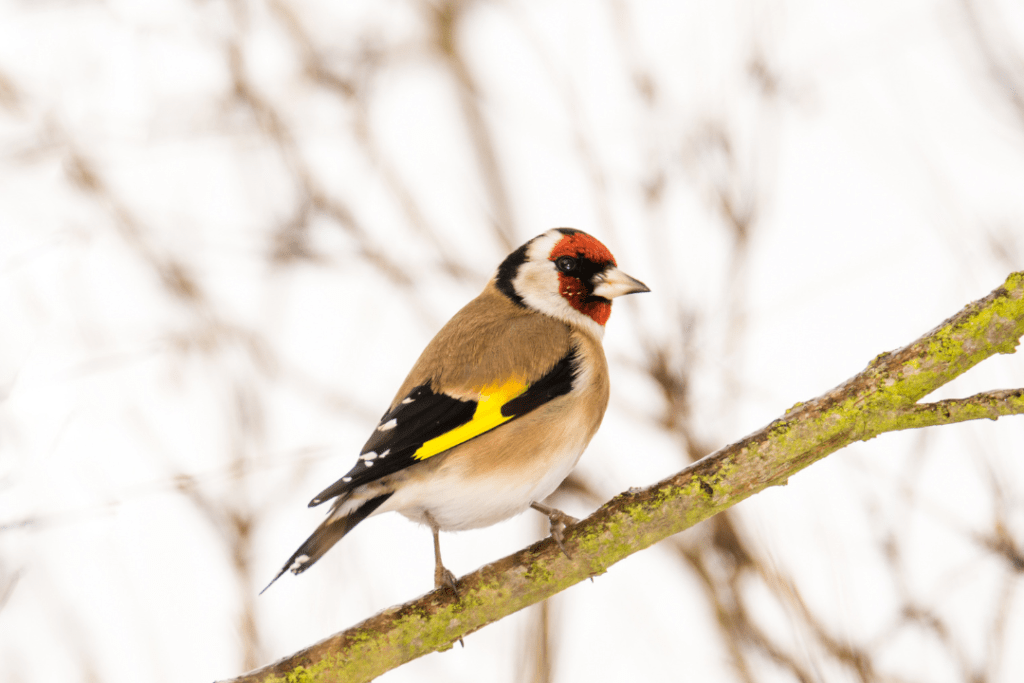
These birds aren’t just about beauty; they’re equipped with a charming personality too. They flit around in lively flocks, filling the air with their delightful twitter that sounds like a gentle, melodic conversation. In the wild, they’re often found in patches of thistles and other plants, delicately plucking seeds with their fine beaks. They have a special fondness for seeds, their diet primarily consisting of these, particularly from dandelions, teasels, and, of course, thistles.
Habitat and geographic range
They're all over Europe, North Africa, and western and central Asia, frequenting gardens, parks, and heaths.
Size
These are small birds, around 12 to 13 cm.
Life expectancy
Life is plentiful, spanning up to 8 years or more with a backdrop of human civilization.
Spotting tips
Their melodic twittering is a common soundtrack in European gardens. Keep your eyes peeled at the bird feeders—they love seeds!
12. Common Blackbird
The Common Blackbird, not to be mistaken for the North American blackbirds, is a member of the thrush family and is common in gardens across Europe. The male is a sight to behold with glossy black plumage that seems to absorb light, giving it a mystical allure. This darkness is broken only by the yellow ring around its eyes and the bright yellow beak, creating a striking visual contrast that has captivated bird lovers for centuries. The female, on the other hand, boasts a more subdued, brown plumage, which serves as excellent camouflage while she incubates her eggs and cares for her young.
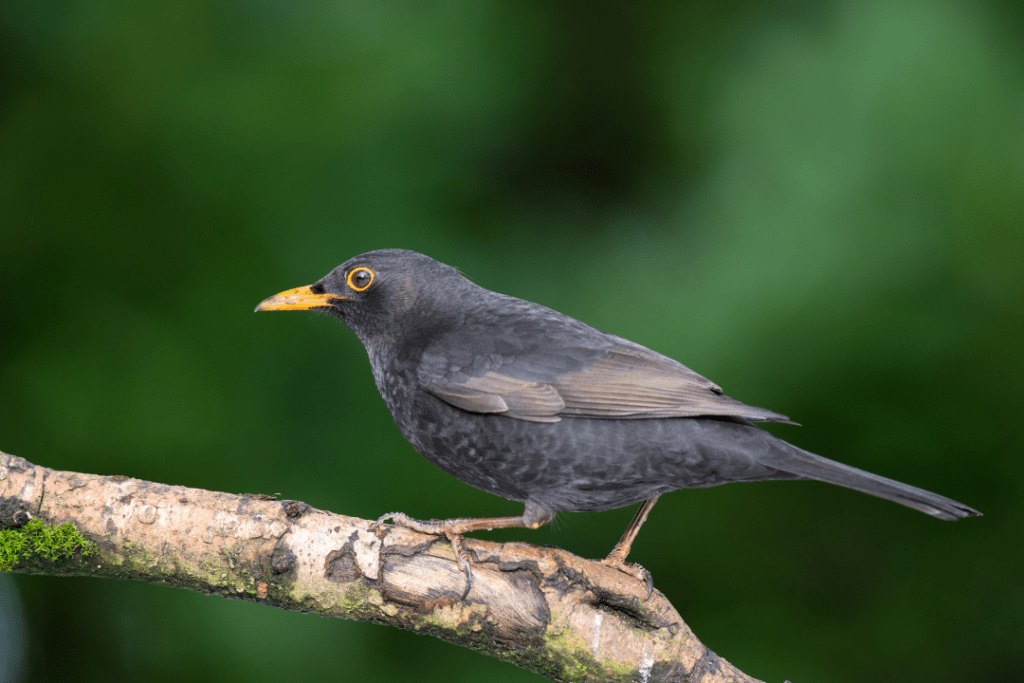
It’s not just the appearance that makes the Common Blackbird special; it’s their song. Males serenade the neighborhood with their rich, melodious tunes that can be heard at dawn or dusk. Their music is not just pleasant; it’s powerful and clear, turning every garden into a concert hall. These performances have cemented their status as one of the most beloved birds in their range.
Habitat and geographic range
They're comfortable throughout Europe, Asia, and North Africa, and have been introduced to Australia and New Zealand. Gardens, parks, and woodlands are their homes.
Size
They're medium-sized, standing at 24 to 29 cm.
Life expectancy
These birds can live around 10 to 15 years, sometimes longer due to their adaptable nature.
Spotting tips
Listen for their melodious songs at dawn and dusk, and you might just find one hopping about your garden or local park.
Additional Section: Conservation Status
While many of our feathered friends thrive, others face threats that jeopardize their future. Habitat loss, climate change, and human activity often disrupt their lives with devastating effect.
Among our listed species, the Tricolored Blackbird and Venezuelan Troupial have faced significant challenges due to habitat encroachment and environmental changes. Conservation efforts are underway, focusing on habitat restoration, environmental education, and legal protection measures.
How can you contribute to their survival? Start in your backyard by cultivating a bird-friendly habitat. Participate in local and global conservation initiatives, donate to wildlife organizations, and spread awareness. Respect nesting grounds, avoid using harmful pesticides, and keep cats indoors. Every action, no matter how small, aids in the preservation of these magnificent creatures. Together, we can contribute to a future where birds continue to soar freely.
Conclusion
From the vibrant, sun-kissed fields of the Americas to the quaint backyards of Europe and vast, ancient landscapes of Asia, these black and yellow birds enrich our world with their colors and songs. They’re not just species within ecosystems; they’re ambassadors of their habitats, each with unique roles and contributions.
Their vivid presence reminds us of the beauty we stand to lose without diverse habitats. So, let’s champion for the protection of these feathery friends. By supporting conservation efforts, engaging in responsible birdwatching, and fostering natural habitats, we can ensure these birds continue to brighten our world. Remember, a world teeming with birds is a world teeming with life. 🌿

James has always been an avid outdoorsman. Since a kid, he kept a journal of all the different birds and species he saw. Now he wants to share his passion with other birders with Happy Birding!
